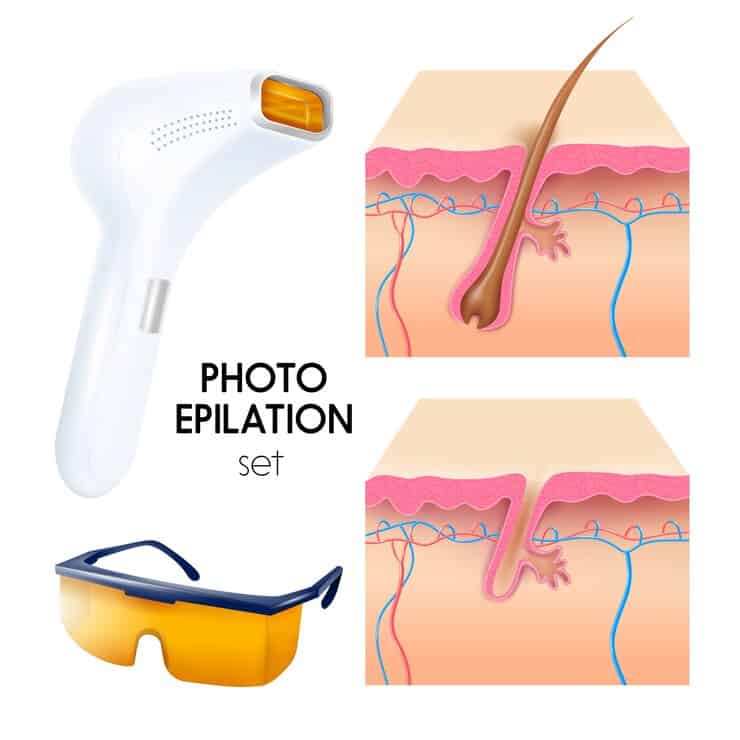The Science Behind Laser Hair Removal

The Science Behind Laser Hair Removal
Tackling unwanted hair has long been a pursuit of both men and women, with various methods employed throughout history. However, in recent decades, laser hair removal has emerged as a leading solution, offering long-lasting results and minimal discomfort. But what exactly is the science behind this increasingly popular procedure? In this exploration, we delve into the intricate mechanisms that make laser hair removal effective, shedding light on the technology that promises smoother, hair-free skin for those seeking a permanent solution to their grooming woes.
Evolution of Hair Removal Techniques
Throughout history, humans have devised diverse methods to tackle unwanted hair. Ancient civilizations resorted to crude techniques like rubbing the skin with abrasive materials such as pumice stones or employing early depilatory creams. The 18th-century introduction of razors marked a significant advancement, offering a more efficient but temporary solution.
Subsequent centuries witnessed the rise of waxing and electrolysis, providing longer-lasting results. However, it was not until the late 20th century that laser hair removal emerged, presenting a revolutionary approach. Unlike its predecessors, laser technology offers a more permanent solution, marking a pivotal evolution in the quest for smooth, hair-free skin.
The Rise of Laser Hair Removal
In the late 20th century, laser hair removal transformed the landscape of dermatology and aesthetics. This non-invasive procedure swiftly gained popularity owing to its unparalleled ability to provide enduring hair reduction with minimal discomfort. Diverging from conventional methods like waxing or shaving, which yield fleeting results, laser hair removal precisely targets hair follicles, interrupting their growth cycle to impede future hair regrowth.
Propelled by technological strides and heightened accessibility, laser hair removal has emerged as the favored option for those desiring a lasting remedy to unwanted hair, solidifying its status as a cornerstone in modern cosmetic procedures.
Understanding the Basics of Laser Technology
Laser technology utilized in hair removal operates on the principle of selective photothermolysis. This process involves targeting melanin, the pigment responsible for hair color, with specific wavelengths of light. The laser emits concentrated beams of light that are absorbed by the melanin in the hair follicles, generating heat.
This heat damages the follicles, inhibiting future hair growth while leaving surrounding skin unharmed. Different types of lasers and wavelengths are used depending on the individual’s skin and hair color. Understanding the fundamentals of laser technology is crucial for ensuring safe and effective hair removal treatments.
How Laser Targets Hair Follicles
Laser hair removal targets hair follicles through a process known as selective photothermolysis. This technique involves delivering controlled pulses of laser light to the treatment area, where the melanin in the hair follicles absorbs the light energy. As the melanin absorbs the light, it converts it into heat, damaging the follicles while leaving the surrounding skin unaffected.
The heat generated by the laser destroys the follicles’ ability to produce new hair, resulting in long-term hair reduction. Laser hair removal treatments are customized based on the individual’s skin and hair color to achieve optimal results while minimizing the risk of adverse effects.
Types of Lasers Used in Hair Removal

laser-epilation-hair-removal-therapy_1303-23982
When it comes to laser hair removal, various types of lasers are employed, each with distinct characteristics and suitability for different skin types and hair colors. Understanding these variations is crucial for ensuring effective and safe treatment. Here are five common types of lasers used in hair removal:
- Alexandrite Laser: Known for its effectiveness on lighter skin tones, the Alexandrite laser offers rapid treatment sessions and is particularly efficient for treating larger areas like the legs or back.
- Diode Laser: Ideal for darker skin types, the Diode laser penetrates deeper into the skin, targeting melanin in the hair follicles while minimizing the risk of pigment changes.
- Nd:YAG Laser: Versatile and suitable for all skin types, the Nd:YAG laser’s longer wavelength makes it effective for treating finer hairs and deeper follicles, making it an excellent choice for darker skin tones.
- IPL (Intense Pulsed Light): Although technically not a laser, IPL emits a broad spectrum of light to target melanin in the hair follicles. IPL systems are adaptable and can be adjusted to suit various skin types and hair colors.
- Ruby Laser: While less commonly used today, the Ruby laser was one of the first lasers developed for hair removal. It is most effective on lighter skin tones and fine hair.
Factors Influencing Laser Hair Removal Effectiveness
Several factors influence the effectiveness of laser hair removal treatments. Skin and hair color play a crucial role, as lasers target melanin in the hair follicles. Lighter skin with darker hair typically yields the best results, as the contrast allows for more effective treatment.
Additionally, the thickness and density of the hair, as well as hormonal imbalances, can affect treatment outcomes. The skill and experience of the practitioner, along with adherence to recommended treatment protocols, also contribute to the success of laser hair removal.
Safety Considerations in Laser Hair Removal
While laser hair removal is generally safe when performed by trained professionals, certain safety considerations must be addressed. Protective eyewear is essential for both the patient and the practitioner to shield the eyes from laser light. Skin cooling methods, such as cryogen spray or contact cooling, help minimize discomfort and reduce the risk of adverse effects like burns or pigmentation changes.
Proper assessment of the individual’s skin type, hair color, and medical history is crucial to determine the most suitable treatment parameters and minimize the risk of complications.
What to Expect During a Laser Hair Removal Session
During a laser hair removal session, the treatment area will be cleansed, and the patient may be provided with protective eyewear. The practitioner will adjust the laser settings based on the individual’s skin type, hair color, and treatment goals. A cooling gel or device may be applied to the skin to enhance comfort and protect the epidermis. The laser handpiece is then applied to the skin, delivering controlled pulses of light to target the hair follicles.
Patients may experience a sensation of heat or mild discomfort during the procedure, but it is generally well-tolerated. After the session, sunscreen and soothing creams may be recommended to protect the skin and alleviate any temporary redness or irritation.
Post-Treatment Care and Maintenance
After undergoing laser hair removal treatment, proper post-treatment care is essential to ensure optimal results and minimize the risk of complications. Patients are typically advised to avoid sun exposure and apply sunscreen regularly to protect the treated area from UV radiation.
Avoiding hot baths, saunas, and vigorous exercise for a few days post-treatment can help reduce irritation. Moisturizing the skin and avoiding harsh chemicals or exfoliants can promote healing and prevent ingrown hairs. Following the practitioner’s instructions regarding post-treatment care is crucial for achieving smooth, hair-free skin.
Long-Term Benefits of Laser Hair Removal
One of the primary advantages of laser hair removal is its long-term effectiveness. Unlike temporary methods such as shaving or waxing, laser hair removal targets the root of the hair follicle, leading to significant reduction or permanent removal of unwanted hair over time.
With multiple treatment sessions, patients can achieve smooth, hair-free skin in the treated areas. Additionally, laser hair removal can save time and money in the long run by eliminating the need for frequent maintenance and reducing the risk of ingrown hairs and skin irritation associated with traditional hair removal methods.
Addressing Common Misconceptions About Laser Hair Removal
Despite its widespread popularity, laser hair removal is often surrounded by myths and misconceptions. Common misconceptions include concerns about pain, safety, and effectiveness. In reality, laser hair removal is generally well-tolerated, with minimal discomfort and low risk of adverse effects when performed by a qualified practitioner.
Additionally, laser hair removal is suitable for a wide range of skin types and can safely target various areas of the body. By addressing these misconceptions and providing accurate information, individuals can make informed decisions about whether laser hair removal is right for them.
Comparing Laser Hair Removal with Traditional Methods
When comparing laser hair removal with traditional hair removal methods such as shaving, waxing, and depilatory creams, several factors come into play. Laser hair removal offers longer-lasting results, with significant reduction or permanent removal of hair over time.
Unlike temporary methods that only remove hair at the surface, laser hair removal targets the root of the hair follicle, leading to smoother skin and fewer ingrown hairs. While laser hair removal may require multiple sessions for optimal results, it provides a more permanent solution compared to traditional methods, making it a popular choice for individuals seeking lasting hair reduction.
Future Trends and Innovations in Hair Removal Technology
As technology continues to advance, the field of hair removal is evolving with innovative treatments and techniques. Future trends in hair removal technology may include advancements in laser technology, such as faster treatment times, increased efficacy, and enhanced safety features.
Additionally, emerging technologies such as radiofrequency and ultrasound-based devices may offer alternative options for hair removal, particularly for individuals with darker skin tones or finer hair. Personalized treatment plans tailored to each individual’s unique characteristics and preferences may also become more prevalent, providing targeted solutions for optimal results.
Understanding the science behind laser hair removal is key to making informed decisions about your grooming journey. At American Laser Med Spa in Amarillo, TX, we’re committed to providing cutting-edge treatments backed by scientific principles. Say goodbye to the hassle of temporary hair removal methods and embrace the lasting results offered by laser technology.
Ready to experience the benefits for yourself? Schedule a consultation with our expert team today by calling (806) 356-7770. Let us help you achieve smoother, hair-free skin and boost your confidence with our state-of-the-art laser hair removal services.






